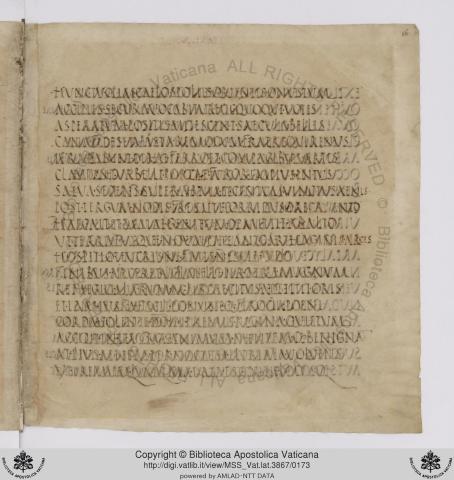At pius Aenēās per noctem plūrima volvēns,305
ut prīmum lūx alma data est, exīre locōsque
explōrāre novōs, quās ventō accesserit ōrās,
quī teneant (nam inculta videt), hominēsne feraene,
quaerere cōnstituit sociīsque exācta referre.
Classem in convexō nemorum sub rūpe cavātā310
arboribus clausam circum atque horrentibus umbrīs
occulit; ipse ūnō graditur comitātus Achātē
bīna manū lātō crīspāns hastīlia ferrō.
Cui māter mediā sēsē tulit obvia silvā
virginis ōs habitumque gerēns et virginis arma315
Spartānae, vel quālis equōs Thrēïssa fatīgat
Harpalycē volucremque fugā praevertitur Hebrum.
namque umerīs dē mōre habilem suspenderat arcum
vēnātrīx dederatque comam diffundere ventīs,
nūda genū nōdōque sinūs collēcta fluentēs.320
Ac prior 'Heus,' inquit, 'iuvenēs, mōnstrāte, meārum
vīdistis sī quam hīc errantem forte sorōrum
succīnctam pharetrā et maculōsae tegmine lyncis,
aut spūmantis aprī cursum clāmōre prementem.'
notes
Manuscripts: M 305-320, 321-324 | P 305-322, 323-324 | R 305-306, 307-324
Aeneas goes to reconnoiter; his mother meets him, disguised as a young huntress, and asks if he has seen another huntress pas by (Austin).
305: pius: here pointing to a leader’s dutiful care for his followers (Conway). volvens: “who had been pondering” (C-R). A free use of the present participle for the past...equivalent to qui volvebat, or volverat (Frieze). Used for the (missing) perfect participle active, or for a clause, cum volvisset (F-B) (AG 496).
306: ut primum: “as soon as”... this clause denotes the time of constitutit, not of the infinitives (Frieze). lux alma: “kindly light” (F-B). exire: the four infinitives in the sentence depend on constituit in 309 (Walpole).
307: explorare: governs both a direct object and an objective clause. quaerere is added because of the parenthesis (Storr). quas vento accesserit oras, qui teneant: indirect questions depending on quaerere, 309 (F-B) (AG 574). vento: ablative of cause, literally, “by reason of the wind” (F-B) (AG 404). oras: governed by ad in accesserit (G-K).
308: qui teneant: supply ea loca (Robertson). inculta: refers to locos and oras (Frieze) (AG 287.3). A substantive (Walpole). hominesne feraene: sc. sint. This use of -ne…-ne for -ne...an or utrum...an is poetical (F-B).
309: sociis: dat. after referre (Robertson). exacta: “results,” literally, “things done” (F-B). “His discoveries” (Walpole). = certa (Chase).
310: in convexo nemorum: “in the hollow of the groves” (Walpole). Nemorum, an explanatory genitive (Storr).
311–312: clausam...occulit: = ita occulit ut clausa sit (Storr).
311: circum: adv. (Robertson). clausam...circum: = circumclausam (Carter).
312: comitatus Achate: The regular form would be Achate comitante (Frieze). comitatus, though from a deponent verb, has a full passive sense... Achate is an ablative of accompaniment, without cum (F-B) (AG 190b).
313: bina: used for duo with objects taken in pairs (F-B) (AG 137d). A distributive adj. (Robertson). lato ferro: ablative of quality (F-B).
314: cui mater sese tulit obvia: literally, “opposite whom his mother presented herself,” i.e., “across his path came his mother”; obvia poetical for obviam (F-B). cui: dative after obvia (Walpole) (AG 384). obvia: in agreement with the subject in preference to the natural agreement with se (C-R).
315: habitum: “appearance,” not “dress” (F-B). gerens: “with” (F-B).
316: Spartanae vel qualis…: “a Spartan maiden, or such a one as Thracian Harpalyce, when she wearies horses.” We often have with qualis, as here, not only an ellipsis of its antecedent, talis, but also of a verb, and sometimes of a connective. Here all three are omitted; namely, talis, est, quae (or cum) (Frieze). construe—vel talis qualis Threissa Harpalyce est quae fatigat, etc. (Walpole). Spartanae: sc. virginis (Walpole). fatigat: i.e., tires by outrunning; hyperbole (F-B). The present, because Harpalyce was a subject of art or poetry (Storr).
317: Harpalyce: daughter of Harpalycus, king of Thrace (Walpole). fuga: ablative of specification (AG 418). Hebrum: the Hebrus (now Maritza) is a river of Thrace, and being in a mountainous country is thought of as swift, though in reality it is rather sluggish (F-B).
318: umeris: = ab umeris (Walpole). Ablative of separation (F-B). de more: “after the custom” (F-B). habilem: “well suited,” i.e., to the person carrying the bow, whether he were strong or weak (Robertson).
319: dederatque comam diffundere ventis: “and had given her hair to the winds to scatter” (F-B). The infinitive is here used to express purpose instead of the usual gerundive with comam (Carter) (AG 460).
320: nuda genu: “her knee bare.” genu is a Greek accusative of specification (F-B) (AG 397b). Acc. of respect (Robertson). Acc. of limitation, or synecdochical acc. (Chase). nodoque sinus collecta fluentes: “having her flowing robes gathered in a knot” (F-B). sinus: acc. after collecta (Robertson). Accus. of specification (Walpole) (AG 397b). collecta: The perf. pass. partic. is sometimes used in an active force, pointing out what a person has done for himself, and is then followed by an accus. (Robertson) (AG 493.1).
321–324: The order is: —monstrate si vidistis quam mearum sororum, succinctam pharetra et tegmine maculosae lyncis, errantem hic forte, aut prementem cursum spumantis apri clamore (Robertson).
321: prior: “first” (AG 290–291a). monstrate: sc. eam; “point her out” (F-B).
322: vidistis si quam: this is not an indirect question “tell me if ( = whether) you have seen,” but a true conditional clause, “show me, if ( = in case) you have seen” (C-R) (AG 515). quam: = aliquam (Walpole).
323: succinctam pharetra: “girt with a quiver,” i.e., with a quiver fastened on by a belt (F-B). [add image]
vocabulary
Aenēās, ae, m.: 1. A Trojan chief, son of Venus and Anchises, and hero of the Aeneid, 1.92. 2. Aenēās Silvius, one of the Alban kings, 6.769.
volvō, volvī, volūtus, 3, a.: to roll, 1.86; roll along or down, 1.101; roll or cast up, 3.206; toss, hurl, 12.906; roll over, roll in the dust, 12.329; cast, hurl down, 1.116; 9.512; roll, wheel, 1.163; of books, open, unroll, 1.262; of the Fates, fix the circle of events, decree, ordain, dispose, 1.22; 3.376; of the mind, revolve, meditate, reflect upon, 1.305; pass, continue, live through, experience, endure, suffer, 1.9; rotam volvere, to complete a cycle, period; (pass.), volvī, roll over, roll, 10.590; turn or wind about, 7.350; to be shed, to flow, 4.449; roll on, revolve, 1.269.
almus, a, um: adj. (alō), giving nourishment; fostering, genial, blessing, blessed, benign, 1.306; fruitful; gracious, kind, kindly, propitious, 7.774.
exeō, īvī or iī, itus, īre, irreg. n. and a.: to go out or forth, 1.306; come out, 5.492; overflow, burst forth, 2.497; avoid, elude, 5.438.
explōrō, āvī, ātus, 1, a.: to ascertain by calling out; investigate, search; reconnoiter, explore, examine, 1.307; observe, 3.514; find out, determine, 1.77.
accēdō, cessī, cessus (perf. ind., accēstis for accessistis, 1.201), 3, n.: to go or draw near to; approach, with acc. alone, 1.307. (ad and cedo)
ōra, ae, f.: a margin, border, 12.924; coast, shore, 3.396; region, 2.91; rim, extremity, 10.477; pl., outline, compass, 9.528.
incultus, a, um: (adj.), uncared for, neglected, unshorn, 6.300; wild; subst., inculta, ōrum, n. pl., waste, desert regions, 1.308.
exigō, ēgī, āctus, 3, a.: to drive out or work out; drive through, thrust, 10.682; drive, 2.357; investigate, examine, ascertain, 1.309; weigh, consider, determine, 4.476; fulfill; finish, complete, 6.637; of time, spend, pass, 1.75; p. subst., exācta, ōrum, discoveries, 1.309. (ex and agō)
convexum, ī, n.: a convexity; recess, 1.310; pl., convexa, ōrum, vault, arch, 4.451; the concave vaulted sky or heavens, 6.241; convexities, sloping or hollow sides, 1.608.
rūpēs, is, f.: a rock, cliff, crag, ledge, freq.; quarry, 1.429. (rumpō)
cavō, āvī, ātus, 1, a.: to hollow or scoop out; p., cavātus, a, um, hollowed out; vaulted, 1.310. (cavus)
circum: (adv.), about, around; (prep. with acc.), around, about.
horrēns, entis: bristling, bristly, 1.634; rough, roughening, 1.165; fierce, 10.237. (horreō)
occulō, culuī, cultus, 3, a.: to cover up; hide, conceal, 1.312; p., occultus, a, um, secret, hidden, 3.695.
gradior, gressus sum, 3, dep. n.: to step, walk, go, 1.312; move, advance, 10.572.
comitor, ātus sum, 1. dep. a.: to accompany, attend, follow, 3.660; p., comitātus, a, um, attended, accompanied, 1.312, et al. (comes)
Achātēs, ae, m.: Achates, a companion of Aeneas, 1.174, et al.
bīnī, ae, a: (adj. num. distrib.), two by two; two to each, 5.61; (poet. as cardinal), two, 1.313, et al. (bis)
manus, ūs, f.: the hand, 1.487; freq.; (meton.), action, movement of the hand; work, art, handiwork, 3.486; prowess, heroic deed, action, 2.434; force, violence, 2.645; a collection of persons; a band, crew, troop; an army, 2.29; forces, 5.623; multitude, 6.660; pl., manūs, workmen, 11.329; dare manūs, to yield, 11.558; extrēma manus, the finishing hand or touch, 7.572.
crīspō, no perf., ātus, 1, a.: to crisp, curl; to vibrate, brandish, 1.313.
hastīle, is, n.: the shaft of a spear; a spear, lance, javelin, 1.313, et al.; a spear-like sapling or branch; a shoot, 3.23. (hasta)
obvius, a, um: adj. (ob and via), in the way; presenting one's self or itself; meeting, 1.314; against, 6.880; opposing, 9.56; in the way of; exposed to, 3.499; obvius fierī, to encounter, meet, 10.380.
habitus, ūs, m.: the having itself or one’s self; condition, habit; dress, attire, 1.315. (habeō)
Spartānus, a, um: adj. (Sparta), Spartan, 1.316.
Thrēissus, a, um: (adj.), Thracian, 1.316, et al.; subst., Thrēissa, a huntress, 11.858.
fatīgō, āvī, ātus, 1, a.: to weary, tire, 1.316; exhaust, 11.306; goad, 9.610; harass, vex, pursue, 6.533; infuriate, 9.63; rouse, 4.572; beat up, hunt, scour, 9.605; disturb, confound, 1.280; strike upon, beat, 10.304; demand with importunity, clamor for, 7.582.
Harpalycē, ēs, f.: a Thracian huntress, daughter of King Harpalycus, 1.317.
praevertō, vertī, versus, 3, a.: to turn before; to preoccupy, prepossess, 1.721; surpass, 7.807; pass. as dep. (only in pres.), praevertor, to surpass, outstrip, 1.317.
Hēbrus, ī, m.: a river of Thrace, 1.317, et al.; a Trojan slain by Mezentius, 10.696.
umerus, ī, m.: the upper bone of the arm; the shoulder, 1.501, and freq.
habilis, e: adj. (habeō), handy, wieldy, convenient, easily handled, light, 11.555; well formed, 1.318; well fitted for, adapted to, fit for; well fitted, 9.365
suspendō, pendī, pēnsus, 3, a.: to hang up, 6.859; hang, 1.318; p., suspēnsus, a, um, suspended, scarcely touching the ground or water, 7.810; hanging, 8.190; as adj., in suspense, uncertain, doubtful, in doubt, 6.722; anxious, 2.729; filled with awe, 3.372.
arcus, ūs, m.: a bow, 5.500, et al.; the rainbow, 5.88.
vēnātrīx, īcis, f.: a huntress, 1.319; adj., 11.780. (vēnor)
diffundō, fūdī, fūsus, 3, a.: to pour round about, pour out, 10.908; diffuse; spread, multiply, 7.708; to put in disorder, dishevel, 1.319; spread abroad, 4.195.
genū, ūs, n.: a knee, 1.320, et al. (γόνυ)
nōdus, ī, m.: a knot, 1.320, et al.; of a tree, 11.553; bond, 1.296; coil, 2.220; (fig.), difficult point; center of strife, 10.428.
atque, or ac: (conj.), and in addition, or and besides; and, as well, and indeed, and, 1.575; freq.; even, 2.626; in comparisons, as, 4.90; than, 3.561.
heus: (interj.), ho! hilloa! lo there! 1.321, et al.
mōnstrō, āvī, ātus, 1, a.: to show, point out, indicate, 1.444; inform, tell, 1.321; direct, incite, 9.44; ordain, appoint, prescribe, 4.636. (mōnstrum)
sī: (conj.), if, freq.; causal, if, indeed, since, 2.102; equivalent to cum, 5.64, et al.; whether, w. subj., 4.110; w. indic., 1.578; for Ō sī, would that, w. subj., 6.187.
quis, qua or quae, quid or quod: (indef. pron., adj., and subst.), any, some, 2.94, et al.; some one, any one, any body, anything, something, 1.413, et al.; sī quis, nē quis, etc., if any, lest any, etc., freq.; (adv.), quid, as to anything, in anything, at all, freq.; sī quid, if at all, freq.
succingō, cīnxī, cīnctus, 3, a.: to gird beneath; gird up; wrap, 10.634; gird, 1.323. (sub and cingō)
pharetra, ae, f.: a quiver, 1.323, et al.
maculōsus, a, um: adj. (macula), covered with spots; speckled, spotted, 1.323.
tegmen (tegumen), inis, n.: a means of covering; skin, hide, 1.275; clothing, 3.594; shield, 9.577; tegmen crūrum, close-fitting trousers worn by Phrygians, 11.777. (tegō)
lynx, lyncis, c.: a lynx, 1.323, et al.
spūmō, āvī, ātus, 1, n. and a.: to foam, 3.534, et al. (spūma)
aper, prī, m.: a wild boar, 1.324, et al.




